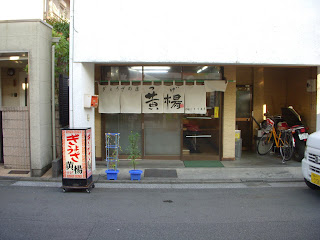Through the mountains to the north, is the small fishing village of Kitaura. The winding road rises up and down, through mountains via tunnels and often skirting alongside a gigantic precapice. In fact, often the road seems to be sandwiched between two equally unpleasant dangers - falling boulders and a drop into oblivion. Add to this the somewhat daring driving of the local people who are well accustomed to the road and you have a rather unique 40 minutes of driving experience.
We were invited to the village for the firework display that happens every summer. It is a tradition to go dressed in traditional attire for a summer evening - a yukata or jimbe; both are very comfortable in the dying heat of the evening.
The fireworks themselves were exceedingly good and were made all the more exciting due to the echoes that rattled around the mountains that enclose the village. Fireworks are often associated to the far east and it comes as little surprise that the Japanese are able to provide an excellent spectacle.
Monday, September 6, 2010
Friday, June 18, 2010
春日神社 Kasuga Shrine
 footbridge and ToriiKasuga Shrine is not the most famous shrine in the centre of Nobeoka but it is a very good one to visit. Kasuga is made up of the Chinese characters 春 which is used for the Japanese word for Spring, 'haru' and 日, the character meaning day, 'hi'. Therefore the name of this shrine can be read as 'Spring Day'.
footbridge and ToriiKasuga Shrine is not the most famous shrine in the centre of Nobeoka but it is a very good one to visit. Kasuga is made up of the Chinese characters 春 which is used for the Japanese word for Spring, 'haru' and 日, the character meaning day, 'hi'. Therefore the name of this shrine can be read as 'Spring Day'. A small and ancient stone footbridge spans a dry bed of what was once a flowing stream. Beyond the bridge, the torii stands as usual, the gateway into the shrine. Hanging from the crossbeam, sacred rope and the white pendants, used in Shinto ritual. Once through the torii, a world of tranquility and peace exists, possibly becuase sedate trees envelop the shrine like a protective shield.
 Kasuga Shrine
Kasuga Shrine At Kasuga, as with all Shinto shrines, it is important to purify oneself before proceeding further into the shrine. This is called 'Temizu' - literally meaning 'hand-water'. Using a ladle one must pour water over your hands and wrists, sometimes your feet also. Sometimes visitors to a shrine may even rinse their mouth too. Once completing this rite, it is possible to walk around the shrine.
Shrines all across Japan become the focus point of New Year celebrations. People go to pray for fortune in the coming year. At Kasuga, the Shinto priest waves a small tree branch adorned with white pennants to bring worth good luck and health. Once the prayer is completed, a person claps his hand together twice and rattles a fairly large bell. Afterwards, it is common to collect your personal fortune, a Omikuji. There are various levels that one can recieve in this sacred lottery, ranging from a great blessing to a great curse.
Saturday, May 29, 2010
GEOS Bankruptcy
The recession has still got a firm grasp around the Japan's neck. Empty shops and sales, symptoms of an unhealthy economy. I am told that the unemployment office is busy too. One of the casualties of the recent financial troubles is GEOS, the company I worked for. Sadly, for everyone in Nobeoka who was someway connected to the school, the company has accumulated huge debts. On the 21st April 2010, the company filed for bankruptcy, meaning my job had evaporated into thin air. Many students had paid huge amounts of money upfront. It doesn't look like they will be able to retrieve it.
Emotions are mixed in such situations; anger, disbelief, despair are only a few. Time will not replace what once was had, but time allows the dust to settle and life to continue.
Monday, March 22, 2010
Gyoza 餃子

Minced meat and chopped vegetables wrapped into a small 'skin' of dough. Gyoza are found across Japan and virtually every Ramen shop offer them as a side dish. Many other restaurants serve them too, and it is possible to buy them at any supermarket. Although the dumplings originate from China, the Japanese have evolved them to a discernable degree. The most obvious difference is that the amount of garlic added to the mixture.
Normally, the Japanese fry the gyoza in a covered pan for a few minutes. A cacophony is produced when water is added. Just prior to serving the moonshaped delicacies are flipped. The result is one side being brown and the other pale. When eating, soy sauce with chilli flakes are a must.

Tsuge 黄楊
In Nobeoka, the best place to get your 'fix' of gyoza is at a place called "Tsuge". This is a gyoza shop and I have been told that that is quite a rare thing. The shop itself is small and only 10 hungry people can eat there at one time; the menu consists of gyoza and rice only. As the gyoza are frying, yet more are being prepared by hand, one at a time with admirable efficiency. The ubiquitous television set in the corner, a bookcase full of comics and the cheery conversation between happy customers furnishes the place with its bright atmosphere. As you would expect from a specialist, the gyoza are supreme. The shop owner (or master, as you say in Japan) and his family are some of the kindest people I have met here.

Master Tokoro
Subscribe to:
Posts (Atom)





